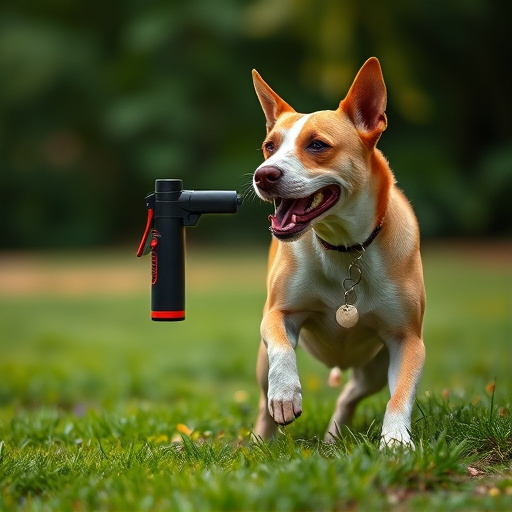Dog spray, containing capsaicin, temporarily disables dogs but requires immediate decontamination for humans and pets (15 minutes of water rinsing). Remove contaminated clothing, rinse skin/fur with water, and use mild, dog-safe soap. Severe reactions need vet assistance. Proper post-exposure care safeguards pet health and minimizes long-term effects from Mace exposure.
“Dog spray, often used by canines as a defense mechanism, can pose a significant threat to human safety. This powerful agent can cause discomfort, irritation, and even severe health issues if not handled promptly. Understanding different types of dog spray and their effects is the first step in self-defense. Following exposure, immediate actions are crucial, including knowing how to decontaminate yourself and your pet after Mace® or similar spray contact. This comprehensive guide will walk you through these essential steps for safety and recovery.”
- Understanding Dog Spray: Types and Effects
- Immediate Actions After Exposure to Dog Spray
- Decontamination Process: Steps to Ensure Safety
- Pet Care and Recovery Following Dog Spray Contact
Understanding Dog Spray: Types and Effects
Dog spray, also known as pepper spray for dogs, is a non-lethal self-defense tool designed to temporarily incapacitate an aggressive canine. It comes in various forms, including aerosol cans and foam, each with unique features. The primary active ingredient in dog spray is capsaicin, the same compound that gives chili peppers their heat. When sprayed, it irritates the dog’s eyes, nose, and respiratory tract, causing temporary disorientation and a desire to retreat.
After exposure to dog spray, decontaminating your pet becomes crucial. This involves rinsing their face, paws, and any other affected areas with plenty of water for at least 15 minutes. Removing the spray residue is essential to prevent potential skin irritation or respiratory issues. Be sure to wash any clothing or gear that came into contact with the spray separately to avoid reapplication on your pet’s fur. Proper decontamination ensures your pet’s well-being and reduces the risk of long-term effects from the spray.
Immediate Actions After Exposure to Dog Spray
If you’ve been exposed to dog spray, the first step is to get out of the area where the spray is present to avoid further inhalation or contact with the irritant. Once safely away, it’s crucial to decontaminate both yourself and your pet as quickly as possible. Begin by removing any clothing that has come into direct contact with the spray, thoroughly rinsing it off with water. For eye exposure, flush the eyes gently but continuously for at least 15 minutes using clean water from a reliable source. If the dog spray has made its way onto your skin or fur, rinse the affected areas liberally with water and consider using a mild soap to help wash away any remaining residue.
For pets, decontamination requires a similar approach. Rinse their eyes gently if the spray made contact with them, and use warm (not hot) water to thoroughly clean any exposed skin or fur. You may need to seek professional veterinary assistance if your pet exhibits severe reactions or if you’re unable to decontaminate them safely at home. Remember, quick action can significantly mitigate the effects of dog spray exposure, so it’s vital to act swiftly and effectively.
Decontamination Process: Steps to Ensure Safety
After a dog spray attack, decontaminating your pet as soon as possible is crucial to ensure their safety and well-being. Start by removing any contaminated clothing or accessories from the affected area. Rinse the exposed skin thoroughly with clean, running water for at least 15 minutes to flush out any remaining chemicals. This step is essential to prevent further irritation or potential damage caused by the spray.
Next, use a mild, dog-safe soap and warm water to gently clean the skin. Pay special attention to areas where the spray made contact. Thoroughly rinse again with clean water, ensuring no soap residue remains. Dry your pet’s fur gently using a soft towel, being careful around their eyes and mouth. If any irritation persists or symptoms worsen, consult a veterinarian for further guidance on decontaminating your pet after Mace exposure.
Pet Care and Recovery Following Dog Spray Contact
After a dog sprays, it’s crucial to act swiftly to decontaminate your pet. The first step is to remove any contaminated clothing and wash the affected areas with warm water and mild soap. This helps to flush out any remaining pepper spray particles. It’s important to pay extra attention to facial areas, paws, and any other high-contact zones where the spray might have concentrated.
Once initial decontamination is complete, consider using a gentle pet shampoo to thoroughly clean your pet’s fur. Rinse well with clean water until all soap residue is gone. Keep an eye out for any signs of irritation or discomfort, and contact a veterinarian if needed. Ensure the area where your pet was sprayed is kept calm and quiet, as stress can exacerbate the effects. Prompt action and gentle care can significantly aid in your pet’s recovery from dog spray exposure.
Dog spray, or mace, can be a frightening experience, but with swift action and proper decontamination, you can ensure your safety and that of your pet. By understanding the different types of dog spray, their effects, and following recommended steps for immediate actions and decontaminating after exposure, you’ll be better equipped to handle such situations. Remember, quick thinking and knowing how to properly decontaminate a pet after mace exposure can make all the difference in their recovery.
